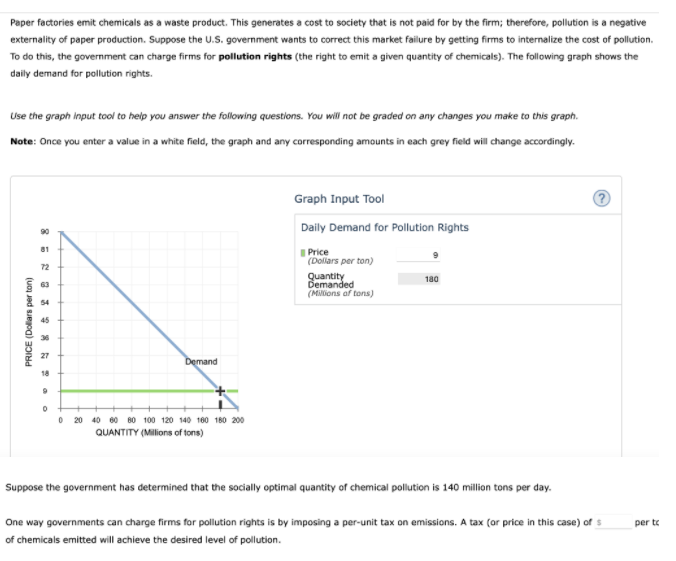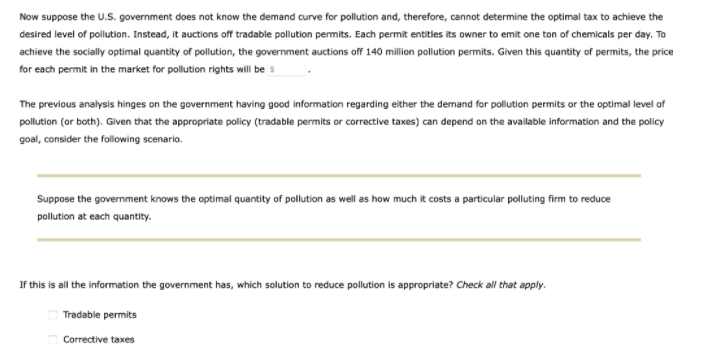Paper factories emit chemicals as a waste product. This generates a cost to society that is not paid for by the firm; therefore, pollution is a negative externality of paper production. Suppose the U.S. government wants to correct this market failure by getting firms to internalize the cost of pollution. To do this, the government can charge firms for pollution rights (the right to emit a given quantity of chemicals). The following graph shows the daily demand for polution rights. Use the graph input tool to help you answer the following questions. You will not be graded on any changes you make to this graph. Note: Once you enter a value in a white field, the graph and any corresponding amounts in each grey fieid will change accordingly. Graph Input Tool Dally Demand for Pollution Rights 01 Price (Dolars per ton) 72 Quantity Bemanded (Mions of tons) 180 45 36 27 Demand 18 20 40 60 80 100 120 140 100 180 200 QUANTITY (Milions of tons) Suppose the government has determined that the socially optimal quantity of chemical polution is 140 million tons per day. One way governments can charge firms for pollution rights is by imposing a per-unit tax on emissions. A tax (or price in this case) of s per te of chemicals emitted will achieve the desired level of pollution. PRICE (Dolars per ton)
Paper factories emit chemicals as a waste product. This generates a cost to society that is not paid for by the firm; therefore, pollution is a negative externality of paper production. Suppose the U.S. government wants to correct this market failure by getting firms to internalize the cost of pollution. To do this, the government can charge firms for pollution rights (the right to emit a given quantity of chemicals). The following graph shows the daily demand for polution rights. Use the graph input tool to help you answer the following questions. You will not be graded on any changes you make to this graph. Note: Once you enter a value in a white field, the graph and any corresponding amounts in each grey fieid will change accordingly. Graph Input Tool Dally Demand for Pollution Rights 01 Price (Dolars per ton) 72 Quantity Bemanded (Mions of tons) 180 45 36 27 Demand 18 20 40 60 80 100 120 140 100 180 200 QUANTITY (Milions of tons) Suppose the government has determined that the socially optimal quantity of chemical polution is 140 million tons per day. One way governments can charge firms for pollution rights is by imposing a per-unit tax on emissions. A tax (or price in this case) of s per te of chemicals emitted will achieve the desired level of pollution. PRICE (Dolars per ton)
Chapter19: Externalities And Public Goods
Section: Chapter Questions
Problem 19.6P
Related questions
Question

Transcribed Image Text:Paper factories emit chemicals as a waste product. This generates a cost to society that is not paid for by the firm; therefore, pollution is a negative
externality of paper production. Suppose the U.S. government wants to correct this market failure by getting firms to internalize the cost of pollution.
To do this, the government can charge firms for pollution rights (the right to emit a given quantity of chemicals). The following graph shows the
daily demand for pollution rights.
Use the graph Input tool to help you answer the following questions. You will not be graded on any changes you make to this graph.
Note: Once you enter a value in a white field, the graph and any corresponding amounts in each grey field will change accordingly.
Graph Input Tool
Daily Demand for Pollution Rights
90
81
IPrice
(Dollars per ton)
72
Quantity
Demanded
(Milions af tons)
180
63
54
45
36
27
Demand
18
20 40 60 80 100 120 140 160 180 200
QUANTITY (MIllions of tons)
Suppose the government has determined that the socially optimal quantity of chemical pollution is 140 million tons per day.
One way governments can charge firms for pollution rights is by imposing a per-unit tax on emissions. A tax (or price in this case) of s
per to
of chemicals emitted will achieve the desired level of pollution.
PRICE (Dollars per ton)

Transcribed Image Text:Now suppose the U.S. government does not know the demand curve for pollution and, therefore, cannot determine the optimal tax to achieve the
desired level of pollution. Instead, it auctions off tradable pollution permits. Each permit entitles its owner to emit one ton of chemicals per day. To
achieve the socially optimal quantity of pollution, the government auctions off 140 million pollution permits. Given this quantity of permits, the price
for each permit in the market for pollution rights will be s
The previous analysis hinges on the government having good information regarding either the demand for pollution permits or the optimal level of
pollution (or both). Given that the appropriate policy (tradable permits or corrective taxes) can depend on the available information and the policy
goal, consider the following scenario.
Suppose the government knows the optimal quantity of pollution as well as how much it costs a particular polluting firm to reduce
pollution at each quantity.
If this is all the information the government has, which solution to reduce pollution is appropriate? Check all that apply.
Tradable permits
Corrective taxes
Expert Solution
This question has been solved!
Explore an expertly crafted, step-by-step solution for a thorough understanding of key concepts.
This is a popular solution!
Trending now
This is a popular solution!
Step by step
Solved in 3 steps with 1 images

Knowledge Booster
Learn more about
Need a deep-dive on the concept behind this application? Look no further. Learn more about this topic, economics and related others by exploring similar questions and additional content below.Recommended textbooks for you


Principles of Microeconomics
Economics
ISBN:
9781305156050
Author:
N. Gregory Mankiw
Publisher:
Cengage Learning

Essentials of Economics (MindTap Course List)
Economics
ISBN:
9781337091992
Author:
N. Gregory Mankiw
Publisher:
Cengage Learning


Principles of Microeconomics
Economics
ISBN:
9781305156050
Author:
N. Gregory Mankiw
Publisher:
Cengage Learning

Essentials of Economics (MindTap Course List)
Economics
ISBN:
9781337091992
Author:
N. Gregory Mankiw
Publisher:
Cengage Learning

Principles of Economics, 7th Edition (MindTap Cou…
Economics
ISBN:
9781285165875
Author:
N. Gregory Mankiw
Publisher:
Cengage Learning

Principles of Economics (MindTap Course List)
Economics
ISBN:
9781305585126
Author:
N. Gregory Mankiw
Publisher:
Cengage Learning

Principles of Microeconomics (MindTap Course List)
Economics
ISBN:
9781305971493
Author:
N. Gregory Mankiw
Publisher:
Cengage Learning